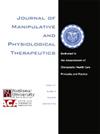Regional Sensorimotor Effects of Chiropractic Spinal Manipulation: Preliminary Results From an Experimental Study
IF 1.4
4区 医学
Q4 HEALTH CARE SCIENCES & SERVICES
Journal of Manipulative and Physiological Therapeutics
Pub Date : 2023-06-01
DOI:10.1016/j.jmpt.2024.08.006
引用次数: 0
Abstract
Objective
The purpose of this study was to assess the effects of different spinal manipulation (SM) techniques and target segments on a specific dermatome and myotome, when compared with a remote spinal cord segment that served as a control location.
Methods
Twenty-nine healthy volunteers were randomized to receive instrumental (Activator IV, Activator Methods International Ltd) or manual SM at the C6, C1, and T4 vertebral segments in 3 independent sessions. Pressure pain thresholds (PPTs) and muscle strength were examined at the C6 (test) and L4 (control) dermatomes and myotomes, at baseline and after intervention. Linear mixed-effects models were used to analyze changes over time and interindividual variability.
Results
Pressure pain thresholds significantly increased at both proximal and distal C6 dermatome locations (P < .05), irrespective of the technique and segment of application (P > .2). No significant changes were observed at the L4 dermatome. Muscle strength remained unchanged throughout the study. Multilevel modeling revealed significant associations between increased PPTs along the C6 dermatome (P < .001), whereas the combination of technique and target segment predicted PPT increases at the proximal C6 dermatome.
Conclusion
These findings support regional, rather than segmental mechanisms underlying the sensory effects of SM. Specifically, significant increases in PPTs along the C6 dermatome suggest localized effects on pain sensitivity, which may depend on the target spinal region. Further investigation is needed to better understand these regional changes of SM and their potential clinical implications.
脊骨神经科脊柱手法治疗的区域感觉运动效应:实验研究的初步结果
研究目的本研究的目的是评估不同脊柱手法(SM)技术和目标节段对特定皮丘和肌丘的影响,并与作为对照位置的偏远脊髓节段进行比较:29名健康志愿者被随机分配到C6、C1和T4椎体节段接受器械(Activator IV,Activator Methods International Ltd)或手法治疗,分3次独立进行。对基线和干预后 C6(测试)和 L4(对照)皮节和肌节的压痛阈值 (PPT) 和肌力进行了检测。线性混合效应模型用于分析随时间的变化和个体间的差异:结果:无论采用哪种技术和哪段应用(P > .2),C6皮膜近端和远端位置的压痛阈值都明显增加(P < .05)。在 L4 皮膜处未观察到明显变化。在整个研究过程中,肌肉力量保持不变。多层次建模显示,PPTs 的增加与 C6 皮节之间存在显著关联(P < .001),而技术和目标节段的组合可预测 C6 近端皮节的 PPTs 增加:这些研究结果支持 SM 感觉效应的区域性而非节段性机制。结论:这些研究结果支持SM感觉效应的区域机制,而非节段机制。具体来说,C6皮节的PPTs明显增加表明对疼痛敏感性的局部影响可能取决于目标脊柱区域。要更好地了解 SM 的这些区域性变化及其潜在的临床影响,还需要进一步的研究。
本文章由计算机程序翻译,如有差异,请以英文原文为准。
求助全文
约1分钟内获得全文
求助全文
来源期刊
CiteScore
3.00
自引率
7.70%
发文量
63
审稿时长
29 weeks
期刊介绍:
The Journal of Manipulative and Physiological Therapeutics (JMPT) is an international and interdisciplinary journal dedicated to the advancement of conservative health care principles and practices. The JMPT is the premier biomedical publication in the chiropractic profession and publishes peer reviewed, research articles and the Journal''s editorial board includes leading researchers from around the world.
The Journal publishes original primary research and review articles of the highest quality in relevant topic areas. The JMPT addresses practitioners and researchers needs by adding to their clinical and basic science knowledge and by informing them about relevant issues that influence health care practices.

 求助内容:
求助内容: 应助结果提醒方式:
应助结果提醒方式:


